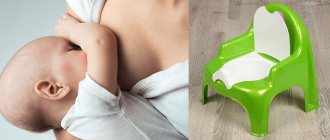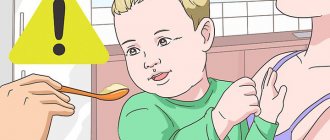In infancy, the doctor judges the child’s health and development based on objective and visible factors. A newborn baby cannot tell what is hurting him, and based on the nature of the crying, even if it varies, it is impossible to make an accurate diagnosis. The doctor can assess the child’s condition by his reaction to sound, light, touch, as well as by the number of urinations and stool consistency. It is the stool of a newborn during breastfeeding that is one of the important criteria that helps to timely suspect and diagnose problems with physical health.
Features of the digestive system in children
During intrauterine development, the baby's digestive system does not work, since all nutrients enter through the placenta with the blood. The first “start” of digestion occurs in the first minutes of life, when the newborn is placed on the mother’s breast. At this point, nature has already laid down some structural features of the children's digestive system.
Structure of the oral cavity. The chewing muscles are very well developed here, despite the child’s small age. The mucous membrane of the lips has a special structure, the gums are thickened, and in the thickness of the cheeks there are special fatty lumps - all this allows the child to eat mother’s milk and make efforts to get it. The sucking reflex in the first days of life is extremely strong and helps to easily cope with new feeding habits.
The work of the salivary glands. The glands are poorly developed and continue to mature as the child grows. The saliva of an adult, in addition to moisturizing the oral mucosa, performs two more important functions - it has a bactericidal effect and takes part in the process of breaking down food. In an infant, these functions are not performed. The lack of bactericidal components leads to the fact that babies often suffer from oral thrush. The lack of enzymatic activity forces the child to eat liquid and unsweetened foods (it is carbohydrates that are broken down by salivary enzymes in adults).
Stomach and pancreas . Unlike adults, children have a horizontal stomach. Its volume in a child of the first month of life is approximately 30-50 ml. That is why you need to feed your newborn often and in small portions. There are sphincters on both sides of the stomach that should not allow food to pass in the opposite direction. However, the upper sphincter in babies is poorly developed, so frequent regurgitation becomes a natural and common problem. The newborn's stomach produces an enzyme that curdles milk, but contains very little lipase, so the fats in cow's milk are not broken down in the infant. The secretion of the stomach during regurgitation is precisely curdled milk. Pancreatic enzymes at this age are well developed, but their activity is still significantly lower than in an adult, so the food of an infant should be easily digestible and easily digestible.
Liver and gall bladder. These are one of the main organs that are involved in digestion. If proteins are broken down in the stomach, then the body breaks down fats with the help of bile enzymes. The amount of bile acids in a child is very small, so fatty foods should be avoided in the diet. The liver also stores glycogen, a material for energy. However, in infants this process is poorly developed and normalizes closer to 7 years. Liver health is very important for detoxification function. In newborn children, the liver is not yet mature enough and its development can be disrupted by improper nutrition or, for example, taking medications. Not only the baby, but also the mother should adhere to the diet, since all products enter the child’s body with milk. Bile is also necessary for normal intestinal motility, so problems with these organs can affect the character of the stool.
Intestines. The motor activity of the intestines and stomach in a child is reduced, which causes constipation at an early age. Around 4 months, motor skills improve and the problem goes away. The intestines of a newborn are sterile at birth and are populated with beneficial microflora with mother’s milk, so it is very important to adhere to breastfeeding in the child’s diet. Digestion and absorption of food components occur in the small intestine, and its dysfunction is immediately reflected in the nature of the stool.
If digestive function is disrupted at one of the stages described above, the newborn’s stool changes in consistency, color or smell, which allows the doctor to suspect a problem.
baby feces smell
Over the past decades, the opinion has spread in our society that breastfeeding a child is a difficult task that not everyone can do. There is an opinion that there are breastfeeding mothers, and some mothers only have enough milk for 3-4 months, or even less.
We hasten to inform you that this is far from the case! Most often, this is explained by the fact that young mothers simply do not have the necessary information about breastfeeding, and, unfortunately, this is rarely taught anywhere. Therefore, women can and do feed, sometimes without knowing the basic points that are crucial for successful lactation. In this article we will list them.
1.
It is important for the successful start of breastfeeding to put the baby to the breast early within 1 hour after birth. This is what is important for further breastfeeding. Because with early contact between mother and child, an invisible bond is formed that they will carry throughout their entire lives. In addition, the first drops of colostrum contain a large amount of substances that protect the child from infections, thus, the child is “vaccinated”, and the intestines are populated by the mother’s microflora, and not that of the maternity hospital. Colostrum is sterile, but no one can guarantee the sterility of formula preparation and the cleanliness of the nipple.
2.
Before the baby is first attached to the mother's breast, he should not receive anything from a bottle or any other method. Since it is important that the child’s body gets exactly those nutrients that are intended for the child’s body by nature, thus, they do not disrupt the natural development of the digestive system of the child’s body. In addition, when receiving the breast for the first time, the child captures these moments and then he will take the breast without problems, relying on the first sucking experience. If, instead of the mother’s breast, the child is given a bottle with a nipple, then he understands that he will be fed from a rubber “breast” and the transition to the mother’s breast may not be easy.
If a newborn baby is taken from his mother, and for the first time he receives a pacifier instead of the mother’s breast, then this is dangerous for the child for the following reasons:
- the child does not receive colostrum (which plays an important role in the development of immunity and is the main point of stimulation and establishment of lactation);
- he may experience confusion between his nipples and his nipple and may refuse to latch onto his mother's breast.
This is dangerous for a young mother for the following reasons:
- Due to the confusion between the mother's nipples and the bottle nipples, the baby is reluctant to take the breast, which can lead to improper latch on the breast, cracks and stagnation of milk.
- It takes longer for the milk to come in because the baby is not stimulating the breasts enough.
- The likelihood of hypogalactia, reduction and cessation of breastfeeding increases.
Thanks to WHO research, it has been established that even one or two prelactation feedings from the nipple are enough to prevent breastfeeding from taking place.
3.
After the baby is born, mother and baby should stay in a shared room. It is important that mother and child begin to adapt to each other from the first hours. Mom will learn to understand her child’s signals and respond to them in time. The baby will be able to freely receive the breast when he needs it.
4.
In the first days of a child’s life, he should receive exclusively colostrum and later breast milk. The baby does not need water and other non-nutrients; feeding on breast milk substitutes is dangerous for the baby.
Very often you can hear the question from expectant mothers: “What to do while there is no milk?!” For the first 2 days (sometimes 1-7 days) there is really no milk. For now, there is only colostrum - very high-calorie and easily digestible, saturated with a huge amount of immunoglobulins and beneficial flora, which promotes the passage of meconium (original feces), the formation of the intestinal environment and the cleansing of the body from bilirubin.
There is little colostrum. Very little. And it is right!
Imagine the baby's internal organs - only a few months have passed since they were formed. In utero they were already working, digesting light suspended particles in the amniotic fluid. But this is idle work, training. Now they have to make full money. After all, there will no longer be any nutrition from the mother directly into the blood. You need to extract absolutely all the nutrients from milk yourself. In order for the transition to a fundamentally different way of nutrition to occur smoothly and successfully, nature has provided an intermediate stage - the colostrum period.
It is a small amount of colostrum that allows the baby’s digestive tract and kidneys to try themselves in a new role, to train, get used to new loads and gradually move on to full-time work. Even a large amount of mother’s milk (let alone formula!) during this period creates an unbearable and unnecessary load on a person’s adaptive systems.
Will he be hungry? No. The fact is that in the first days of life, very serious and important processes take place - adaptation to sharply and radically changed living conditions. The child’s body is completely occupied with this adaptation and does not want to waste energy on digestion.
In addition, brown fats are burned in the newborn’s body, which provides almost the entire daily energy requirement. Plus the high energy value of every drop of colostrum. The baby gets everything he needs.
These few simple rules will help you make the first days without milk comfortable:
1. Remember that now the baby only needs colostrum and in exactly the right quantity to keep him healthy. And he doesn't need anything else.
2. Be calm, because the baby is very sensitive to his mother’s mood and begins to cry if his mother is alarmed or wound up.
3. Don’t wait for a cry to give the breast and try not to take it away from the baby yourself.
4. Be together all the time. A small percentage of problematic births involve separation of mother and child.
5. Make feedings comfortable. There are no household chores in the maternity hospital yet, there is only you and the baby. Feed him lying down and rest yourself at the same time.
6. Achieve correct attachment. By latching deeply on the breast, your baby will be able to suckle more effectively and be less tired.
7. Offer him a second breast if he shows dissatisfaction after sucking one for a long time. This will help the proper development of lactation, help avoid excess milk supply, and the baby will receive its invaluable drops of colostrum from both breasts. Then you can offer him the first one again.
5.
In the maternity hospital, the mother should learn how to hold the baby correctly at the breast. The correct attachment of the baby to the mother’s breast depends on this. It would be good to feed the baby in different positions; this will make it easier to remove milk from different lobes and will not cause stagnation. There are three main positions: “cradle” - the traditional, well-known position, “from the armpit” and feeding while lying down, but you can come up with your own, the main thing is to ensure a good attachment. Make sure that in all these positions you feel comfortable, and that the baby’s body is located in the same plane and does not bend. The newborn should lie on his side and his mouth should be at nipple level. In the cradle position, the baby is pressed against the mother's stomach with its legs and tummy.
6.
The mother needs to learn how to properly attach the baby to the breast. Lactation consultants or nurses in the maternity hospital can help the mother with this. When applied correctly, the entire areola or most of it plus the nipple is in the baby's mouth. Thus, the baby’s entire mouth is filled with the breast and when sucking, almost no air enters there, therefore, the baby hardly swallows air. When sucking, no extraneous sounds (clicking or smacking) are heard. The child’s chin and often nose rest against the chest, the lower lip is turned out. It doesn't hurt to feed mom!
7.
The baby should receive breastfeeding on demand. This means that the mother responds to the baby's crying by putting him to the breast. In addition, the baby’s requirement is considered to be such behavior in which the mother sees that he wants to get breasts (search behavior). For example, a child began tossing and turning in his sleep and opening his mouth. The baby is not crying yet, but makes movements with her tongue, as if looking for the breast.
A newborn baby has many reasons for wanting to breastfeed, since in addition to satisfying nutritional needs, the child satisfies the need for psycho-emotional comfort. The baby became scared - he needed to be put to the breast, he wanted to be held in his arms, he felt uncomfortable under new clothes, his heel itched, he wanted to pee - he can react to everything, to this, by crying, and his mother saves him by letting him put to the breast. You should not worry that your baby will overeat; this is practically impossible with exclusive breastfeeding, because his body is genetically tuned to very frequent feedings. For a baby in the first month, it is normal to apply every 1 - 1.5 hours. Be careful not to breastfeed too much rather than overfeed. If the baby eats excess, he will regurgitate the excess, thus, his self-regulatory system will debug everything.
8.
The time the baby spends at the breast is regulated by the baby himself. Don’t rush, he must eat exactly as much milk as he needs, unfortunately, we cannot know this, so we will focus on the baby. Mom can only take the breast if the baby has grabbed it incorrectly and it hurts you. To do this, use your finger, open the gums with it, and take out the breast. We serve it again, but take into account the correct grip of the chest.
9.
You should not transfer the baby to the second breast before he has sucked the first. Do not forget that frequent breast changes can lead to the fact that the baby does not have time to suck out the hind milk, which is richer in fat, so the baby may experience digestive problems, and as a result, lactase deficiency and foamy stools may occur. It is better to act this way: we give one breast at one feeding. If the baby falls asleep very quickly under the breast (5-10 minutes), then you can give the same breast a second time when he wakes up.
10.
It is very important that the baby has free access to the breast at night. It will be very good if you organize a joint night's sleep. It is known that it is at night that the hormone prolactin is produced, which is responsible for milk production the next day. In addition, this is a good opportunity for the mother to get a good night's sleep, since she will not have to constantly get up to soothe the baby and give him the breast. A child, feeling the smell of his mother nearby, also sleeps better and longer.
11.
A breastfed baby should absolutely not receive pacifiers, pacifiers, or bottle feeding. It is known that when sucking a pacifier, a child uses different muscles than he uses when sucking at the breast. Thus, he may learn to suck incorrectly and damage his mother's nipples. For some children, one bottle feeding is enough and the baby begins to refuse to take the mother's breast or to worry under the breast. If the child needs additional feeding, it should be given from a cup or spoon.
Artificial children need pacifiers and nipples so that they can satisfy their sucking need; infants do not need them, they are even useless. They have a mother and a breast, to which they feed on demand.
12.
Exclusively breastfed babies do not need additional water or early introduction of complementary foods until 6 months of age. Firstly, milk contains up to 90% water; they satisfy their need for liquid through milk even in the summer. Secondly, he also does not need supplementary feeding and additional vitamins, since milk contains all the vitamins the baby needs, and they are absorbed by the child’s body completely without residue, unlike vitamins synthesized artificially. It should be remembered that early introduction of complementary foods can have negative consequences. It is known that, receiving additional food up to 6 months, the baby begins to poorly absorb vitamins and microelements from mother’s milk. But, unfortunately, he still does not know how to absorb them from new food.
13.
We must remember that mothers should not get carried away with washing their breasts with soap before and after each feeding, or treating them in any way. Around the nipple are the Montgomery glands, which produce a protective fatty lubricant that protects the nipples from drying out and injury. In addition, this lubricant has a similar odor to amniotic fluid, so the baby will calm down at the breast, feeling the familiar smell. This smell helps the baby determine where the breast is located to which it should be attached. By this smell the child recognizes his mother. If you wash your breast very often, the protective layer is washed off and the nipple can be easily injured. It is enough if you take a shower once every 1-2 days.
14.
Mom should not additionally express milk after each feeding. The task of a young mother is to establish breastfeeding in such a way that the milk flows exactly as much as the baby needs. Additional pumping primes the breasts to produce excess milk; unfortunately, it takes a lot of effort and time. Some mothers who pump after feeding complain: “If it weren’t for constant pumping, I would feed with pleasure! And so I get very tired.” Pumping may only be necessary in certain cases
15.
There is no need to weigh the baby before and after each feeding. These procedures do not provide accurate results about the amount of milk consumed. In addition, they irritate both the child and the mother, who begins to worry about how much the child has eaten in one feeding. It would be more correct to weigh the baby once a week at the same time, in the same clothes. Weekly weight gain should be about 125 g. And for greater peace of mind, perform a wet diaper test. If the baby has good weight gain and 12 or more wet diapers per day, he is in a good mood, this means that he has enough milk and the baby is full.
16.
If the mother has a cold, there is no need to wean the child from the breast during the illness. On the contrary, it is very important to put the baby to the breast at this time. Because during illness, the mother's milk contains antibodies from the disease she is suffering from. The baby, receiving this milk, is vaccinated and thus most often does not get sick. If he does get sick, the illness is not so difficult and the child recovers quickly. If you need to take medication, you can call the consultants at Tender Mom, we will use reference books to find out how compatible this medicine is with breastfeeding.
17.
It is important for young breastfeeding mothers to find communication with those mothers who have had positive, long-term (1-2 years) experience breastfeeding their children. It is this kind of communication that will contribute to successful and long-term feeding, because they will be able to receive support and practical advice, which, in turn, will help to establish breastfeeding.
18.
There is no need to strive to wean a child from the breast after he is 1 year old. It is most physiological to feed children up to 2-3 years of age, when the child is fully mature (both mentally and physically) in order to part with the breast.
First chair
After birth, the baby's first bowel movement is accompanied by the release of original feces, which looks like a thick mixture of black and green color. This discharge is called meconium. It represents all the products that accumulated in the child’s intestines during intrauterine development. Meconium is passed on the first day after birth. As breast milk enters the stool, its color becomes lighter. It is absolutely normal if this does not happen immediately, but on the 3-4th day of life, since before this time the mother secretes colostrum, which can be completely absorbed by the child’s body.
Breastfeeding and feces
As we have already mentioned, meconium is odorless, since it consists of amniotic fluid, epithelial cells and other substances swallowed by the child. It has a tar-like consistency and black-green color.
In the first 10 days, the baby’s own microflora is formed, and his body gets used to mother’s milk. During this period, the stool has a greenish tint and a consistency similar to porridge. There is also a sour smell of feces in breastfeeding infants.
Then, every day, the child’s feces become more mature. It becomes yellow in color and has a uniform consistency. There may be some minor mucus or white flakes, but don't worry, it's just undigested breast milk. In thickness it resembles sour cream. This type of feces has a slight odor, similar to kefir, cottage cheese or sour milk.
The stool of a breastfed baby may change. It depends on the mother's diet. If your child is not worried about anything and is gaining weight steadily, then there is no reason to worry.
Normal baby stool
To notice changes in a child’s stool, you need to know what kind of stool is considered normal.
During the transition from meconium to mature stool, the discharge may have a sour odor and a yellow-green color. Stools that are yellow in color are considered fully mature. Its consistency should be similar to liquid porridge, since the baby feeds only on mother's milk. The smell of discharge is often unpleasant for an adult, but it can be described as sour milk, which is absolutely understandable when breastfeeding. Normally, feces are homogeneous in structure and do not have undigested pieces or pathological inclusions.
The frequency of bowel movements may vary, but it always occurs several times a day (possibly even up to 10). As the child gets older, bowel movements occur less frequently. Infrequent stool in a child over 3 months old can be considered normal if the mother's milk is absorbed so completely that waste does not accumulate in the intestines. However, this rarely happens and, in most cases, insufficient bowel movements are considered constipation and require correction.
The following can be considered a signal of possible pathology:
- Change in stool color, odor, consistency, or consistency.
- The appearance of abdominal pain, flatulence.
- Difficulty with bowel movements.
- Poor weight gain.
Green chair
A greenish tint to the stool at a time when it should already be a mature yellow color should alert the mother. The reasons for this condition may be:
- Dysbacteriosis. If there are not enough beneficial bacteria in the intestines, pathogenic flora develops, which gives the stool a green tint. In this case, additional symptoms appear - diarrhea, abdominal pain, flatulence.
- Inflammatory process in the intestines. It can appear as a result of the mother’s poor diet (abundance of dyes, preservatives, unnatural substances).
- Malnutrition. “Hungry” green stool appears when the mother has insufficient milk production or the baby has difficulty sucking. Additional symptoms of this condition will be poor weight gain, frequent awakenings, and whims when sucking.
- Hypoxia. Sometimes green stools are observed as a consequence of intrauterine hypoxia. If the child is active and gaining weight well, then the pathological discharge is temporary and should soon return to normal.
Possible reasons for deviations
A sour, pungent, putrid, swampy, fetid smell of feces can indicate possible health problems in a child. It may also smell like rotten eggs. In this case, its consistency will be either too liquid or too hard, and its color will be green, gray or black.

Possible reasons for the sour smell of feces in a baby may be:
- Imbalance in nutrition. The stool will be watery, foamy, with a sharp sour odor. Perhaps the baby receives a lot of foremilk with a high sugar content. To correct the situation, you need to either hold the baby longer at one breast (15-20 minutes), or express the first milk.
- Constipation. Often appear in bottle-fed children. Rare bowel movements are observed (less than once a day), this process is painful, and the stool has a hard consistency with the smell of rotten eggs. To help the baby, use fermented milk mixture or laxatives prescribed by the pediatrician.
- Allergy. The stool will be frequent, green in color, foul-smelling, watery in consistency, and may contain mucus or blood. It can occur with both hepatitis and IV. In case of breastfeeding, the mother needs to reconsider her diet and remove from it foods that could cause allergies in the child. In case of IV, replace the mixture with a hypoallergenic one.
- Dysbacteriosis. There is a sour smell in the baby's stool, frequent bowel movements, loose, green stools with foam, mucus or blood. At the same time, the baby often experiences flatulence and poor weight gain. After passing the tests, a course of probiotics may be prescribed. GW helps in this case by accelerating the growth of beneficial bacteria in the child’s intestines. For IV, a medicinal mixture with prebiotics and probiotics is prescribed.
- Lactase deficiency. A very sour smell of feces in a baby indicates an insufficient amount of the enzyme responsible for digesting lactose, that is, milk sugar. The process of defecation is mixed with the release of gases, as increased gas formation is observed. The stool becomes green in color and has a watery, foamy consistency. In such a situation, the mother is advised to reduce her consumption of whole milk, and she is also prescribed an enzyme. Artificial babies are prescribed a low-lactose mixture.
- Infections. The stool develops a strong smell of rot, it becomes liquid, frequent and takes on an uncharacteristic color. All this is accompanied by pain in the epigastric region, vomiting and hyperthermia. The most common cause is rotavirus infection. In this case, you need to call a doctor. Before his arrival, give the child plenty of fluids. Oral rehydration solutions or breast milk are good options.
Yellow chair
Yellow stool color can be either normal or pathological. Additional impurities that should not be present in a healthy state will help to distinguish one from the other:
- White inclusions that look like lumps of undigested food. With normal weight gain, such an admixture may indicate overeating. If the child grows slower than normal, the lumps are a consequence of enzyme deficiency, which leads to poor breakdown of food. This condition will go away on its own as the child grows up. The pediatrician may also prescribe enzyme preparations.
- Slime. Increased mucus formation occurs during inflammatory processes in the intestines. It can also be observed with atopic dermatitis, runny nose, early introduction of complementary foods and other conditions. A doctor will help you correctly determine the cause.
- Foam. This symptom often indicates increased gas formation and dysbacteriosis. Sometimes foamy discharge appears due to an intestinal infection, which is also manifested by diarrhea, fever, vomiting and abdominal pain. In any case, this condition requires consultation with a pediatrician.
- Blood. There should be no blood in the stool. This symptom is considered serious and requires immediate diagnosis. Blood may appear due to mechanical damage to the rectum, intestinal inflammation, allergies or intolerance to cow's milk.
Retention of stool in a child
Delayed or difficult bowel movements rarely bother a breastfed baby. However, this criterion also needs to be monitored, as it indicates the quality of the digestive system.
Constipation is defined as stool that causes excessive strain in the baby and has a dry, hard consistency. At the same time, the very fact of stool retention is not always important. The norm for a child over 3 months old is to defecate from 10 times a day to 1 time in 3 days. When breastfeeding, the reason for rare stools may be the good digestibility of mother's milk. This condition does not require treatment. The consistency of breastfed stool is rarely hard, unlike when feeding with artificial formula. When complementary foods are introduced, the baby's stool will be more formed and predictable, since new foods often cause constipation.
However, changes in stool frequency should not be ignored; it is better to consult a specialist once again. Your pediatrician will help determine the exact cause of delay or difficulty in bowel movements. He will also give nutritional recommendations for the mother, since a proper diet is a safe, affordable and effective way to correct the functioning of the digestive system.
Frequent bowel movements
Diarrhea (too frequent and loose bowel movements) is the other extreme in changing the frequency of stool. Even if the diarrhea is physiological (after foods with a laxative effect), it still negatively affects the child’s health, as it leads to the loss of fluid and beneficial electrolytes, which is dangerous due to dehydration. The treatment regimen always includes sorbents and drugs that restore water and electrolyte balance. Diarrhea differs from the usual single loose stool by the increased frequency of discharge.
With an infectious etiology, the color of the stool may change to green, and the smell will become very unpleasant. The cause of diarrhea must be determined so as not to miss an intestinal infection. Its additional symptoms will be fever, vomiting, and deterioration in the child’s general condition. At birth, the baby's intestines are sterile and are populated with beneficial bacteria through mother's milk. Antibodies to many infections are delivered in the same way, but the newborn’s own immunity is still very weak.
Only a pediatrician should treat all pathological conditions. The mother can independently influence the child’s stool by adjusting her own diet. To do this, you need to eliminate potential allergens, harmful chemical additives, and eat more vegetables. If the child is feeling well and gaining weight, some changes in the nature or frequency of stool may be considered normal. For example, during the period of introducing complementary foods, the baby’s reaction to a new product can be different - from constipation or diarrhea to skin rashes. Over time, the mother will already know the child’s characteristics and understand which changes need to be worried about and which ones not worth worrying about.
Treatment by a gastroenterologist
If symptoms of spasmodic constipation recur regularly in a child, treatment is carried out by a gastroenterologist. The doctor conducts intestinal examinations to confirm or refute pathologies that could cause the appearance of dense stool. When diseases are detected, therapy is aimed at treating them and eliminating constipation.
To soften hard stools, a specialist will recommend drinking 2 liters of clean water a day and eliminating foods that irritate the intestines from your diet.
Treat spasmodic constipation:
- "Duspatalin" (increases peristalsis);
- "Lactusan" (has a laxative effect);
- "Linex" and "Bifiform" (restore intestinal microflora).
In some cases, surgery may be required; it helps solve the problem of intestinal deformities, tumors, and fecal impactions.
Constipation must be treated. Ignoring symptoms leads to accumulation and rotting of stool. Intoxication of the body occurs, the following appears:
- irritability;
- headache;
- bad feeling.
Neglected conditions lead to anal fissures, intestinal prolapse, hemorrhoids, and colon cancer.
Traditional methods of stool regulation
For severe constipation, enemas can be done to soften stool, but not too often. They use warm water, an infusion of herbs, and add oils to them.
It is not recommended to use soap solution. It can cause severe irritation and dry out the skin.
Oils
The use of pharmaceutical, petroleum jelly oil is effective. It is added to water enemas, used in the form of capsules or chewing gum. The maximum daily intake for children is 15 capsules or 2-3 tablespoons of the drug in liquid form. Duration of treatment: 7 days. Then take a short break and repeat the treatment. Almond oil has the same effect; take 2 tablespoons no more than 4 times a day.
Honey and fruits
Honey helps get rid of sheep feces. It is advisable to use it warm. The product is consumed 1 spoon on an empty stomach, washed down with a glass of water. You can enhance the effectiveness of the ingredient by adding prunes or melon. Plums, apricots, kiwis, figs and citrus fruits also help soften stool.
Wheat bran
To normalize the condition of the intestines, it is recommended to consume wheat bran brewed in water in the amount of 2 small spoons. The mixture is consumed 2 hours before breakfast, washed down with 2 glasses of water.
Burdock infusion
To prepare the medicine, pour boiling water over fresh leaves of the plant and leave for 3 hours. Strain the finished liquid, take 1 spoon before bed.










